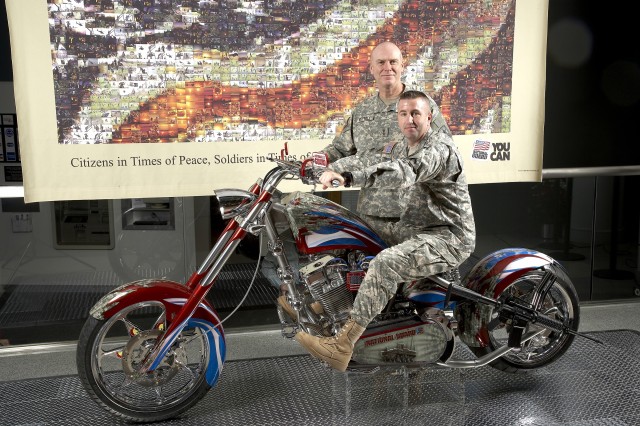WASHINGTON (Army News Service, March 18, 2008) - Capt. Will Germann was lucky.
When he fell off his motorcycle after riding too fast and skidded for 25 yards, he slid onto the sidewalk so oncoming traffic didn't hit him. He was wearing a helmet so he didn't lose the skin on his face.
And instead of dying like 20 Army National Guard Soldiers in fiscal year 2007 and 16 in FY 2006, he broke his left wrist and dislocated his right shoulder. In fact, since the National Guard started keeping track of ARNG motorcycle fatalities in FY 2005, 53 Soldiers have died (15 on duty status, 38 in non-duty status). It is past time to get very serious about motorcycle safety.
After-action reviews of non-duty and duty-related fatalities have found that in many of these tragic instances, both new and experienced riders displayed a lack of training and skill. This is especially concerning to leadership, as with the rising prices of gasoline at the pump and the improving weather, many Soldiers and other riders are heading out on the open road with their bikes.
To help combat this and become aware of who and where ARNG bikers are, the Guard launched an ARNG Motorcycle Rider Web site in February 2008. Every ARNG Soldier and Civilian employee who rides a motorcycle is expected register on this site. This Guard Knowledge Online site will evolve to a very easy tool for ARNG bikers, useful for training registration and information exchange.
Meanwhile, all active-duty and reserve-component riders are encouraged to contact their local safety office to find out the names of other riders and potential riding buddies. Knowledge and skills reinforced with a positive attitude will enhance riders' abilities, enjoyment, and successful motorcycle riding.
The lesson, says Germann, who is now a safety manager with the Arizona National Guard, was a painful one, but he had taken a basic riders course with a safety-conscious instructor so he knew to wear personal protective equipment, and it could have been a lot worse.
"I was fortunate enough to learn where to wear all the PPE recommended for motorcyclists. I was wearing a high visibility yellow jacket with great padding. I was also wearing boots, jeans, gloves, and above all a helmet. I kept the helmet for awhile to remind me of the necessity of them. I slid down the sidewalk face-first. I am not sure if anything would be left of that side of my face if I hadn't been wearing it. I also learned to control my speed," he said.
The Motorcycle Safety Foundation (http://www.msf-usa.org/) has a mnemonic for remembering the keynotes of safety: T-CLOCS. Remember to check your Tires, Controls, Lights, Oil, Chassis, and Stands. Checking your bike and wearing personal protective clothing are essential elements of motorcycle safety, but the real test of readiness for the ride is on the road.
"As a leader as well as a safety professional, it's imperative that I set the example for other Soldiers and other riders in wearing the proper personal protective equipment when riding my motorcycle," said Lt. Col. Richard A. Lipe, a safety and occupational health manager with the Arkansas National Guard. "It would be irresponsible of me to subject myself to unnecessary injury and, if I was seriously hurt or killed, cause my family to bear the burden for my behavior.
"And the last thing I want to do is to degrade my quality of life through an injury to the point that I can't enjoy the things I most enjoy doing."
There are some outstanding motorcycle safety programs across the 54 states and territories. North Dakota's American Bikers Aiming Toward Education program has been especially effective. The North Dakota Motorcycle Safety Program currently offers two classes: the basic rider course and the experienced rider course.
They are also working on a "Top Gun Program" for "graduate" riders. Based on curriculum provided by the MSF, the North Dakota program trained over 1800 riders in 2006 and almost 2200 riders in 2007. It has a fleet of 10 National Guard logo bikes and over 30 rider-coaches.
The National Traffic Safety Administration allocated $100,000 per year from 2006 through 2010 for the ABATE program. Cable-provider MidContinent Communications also donated $200,000 toward the campaign.
Once riders are well prepared with safety courses and well adorned with PPC, riding can be fun or even for a great cause, such as for Prisoners of War (<a href="http://www.rollingthunder1.com/"target=_blank> www.rollingthunder1.com/</a>).
For additional information on motorcycle safety (for example, national motorcycle statistics), see <a href="http://www.nhtsa.dot.gov/"target=_blank> http://www.nhtsa.dot.gov/</a>.
(Maj. Gen. James W. Nuttall is the deputy director of the Army National Guard.)


Social Sharing